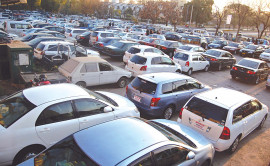
The ongoing structural reforms, aimed at fixing the faltering economy, have crippled almost every sector, particularly the agriculture and large-scale manufacturing sectors, at least for the time being. The economic slowdown has not only prevented employers from hiring fresh graduates and newcomers in the market, but has also forced many of them to lay off staff in order to adjust to the emerging tough working environment. The Economic Survey of Pakistan, unveiled in June 2019, reported a slight drop in the rate of unemployment to 5.79% in fiscal year 2017-18.
Employers, however, have challenged the reading, arguing that it does not reflect the actual bleak situation in the job market. "If we take a holistic approach, it (the rate of unemployment) is not less than 14-15%," Employers' Federation of Pakistan (EFP) President Majyd Aziz told The Express Tribune. "The unemployment numbers reported by different governments from time to time are incorrect," he said. The Economic Survey 2018-19, citing the Labour Force Survey of 2017-18, reported that the unemployment rate had decreased to 5.79% in 2017-18.
In 2017-18, the total civilian labour force was 65.50 million, consisting of 50.74 million males and 14.76 million females. Out of this, 61.71 million (94.21%) were employed and the remaining 3.79 million (5.79%) were unemployed. The unemployment rate in Pakistan, on average, has remained at 5.5% since 1986.
"If the unemployment rate was that low (nearly 5.79%), then it meant that almost every newcomer in the job market was getting a job in Pakistan. This should be a source of great joy and happiness for the people. In America, however, 4% unemployment rate is considered as full employment," Aziz said. "This (5.79% unemployment level) is unrealistic. It means there is no such thing like unemployment in Pakistan."
He claimed that Pakistan had witnessed huge layoffs in recent months. According to an estimate, one million people may lose their jobs due to the ongoing structural reform drive. "Employers have stopped making new appointments. Silent staff retrenchment is going on in the country," he said. "Some 3-3.5 million people come into the job market every year in Pakistan.
We need a sustainable minimum 8% GDP (gross domestic product) growth to provide jobs to almost everyone," the EFP president added.
Contrary to that, the economic growth rate has decelerated to a nineyear low at 3.3% in the fiscal year ended June 30, 2019. "How can the two major sectors of the economy - agriculture and large-scale manufacturing - which are lagging behind create the required employment opportunities?" he asked.
"The economy is not performing well. The agriculture sector has grown a little bit while the large-scale manufacturing sector has contracted for the first time in the past 10 years," he pointed out.
Successive governments have never taken into account two to three things while measuring unemployment. These include the inflow of refugees, migration of people from their hometowns to urban centres (Karachi, Lahore and Islamabad) and semi-rural ones in search of jobs, and growing ranks of unskilled labour due to a high dropout rate at schools and colleges.
Way out? According to Aziz, the construction industry holds the key to providing employment to almost everyone. The government should implement its low-cost five-million housing scheme in true letter and spirit. This will activate the construction and 40-45 allied industries like cement, steel, brick kilns, tiles, paints and woodwork.
They will provide jobs to a majority of the jobseekers including the unskilled labour. Besides, the government needs to come up with a plan for skills development and revival of vocational training centres to train and improve skills of the workforce. THE WRITER IS A STAFF CORRESPONDENT


















COMMENTS
Comments are moderated and generally will be posted if they are on-topic and not abusive.
For more information, please see our Comments FAQ